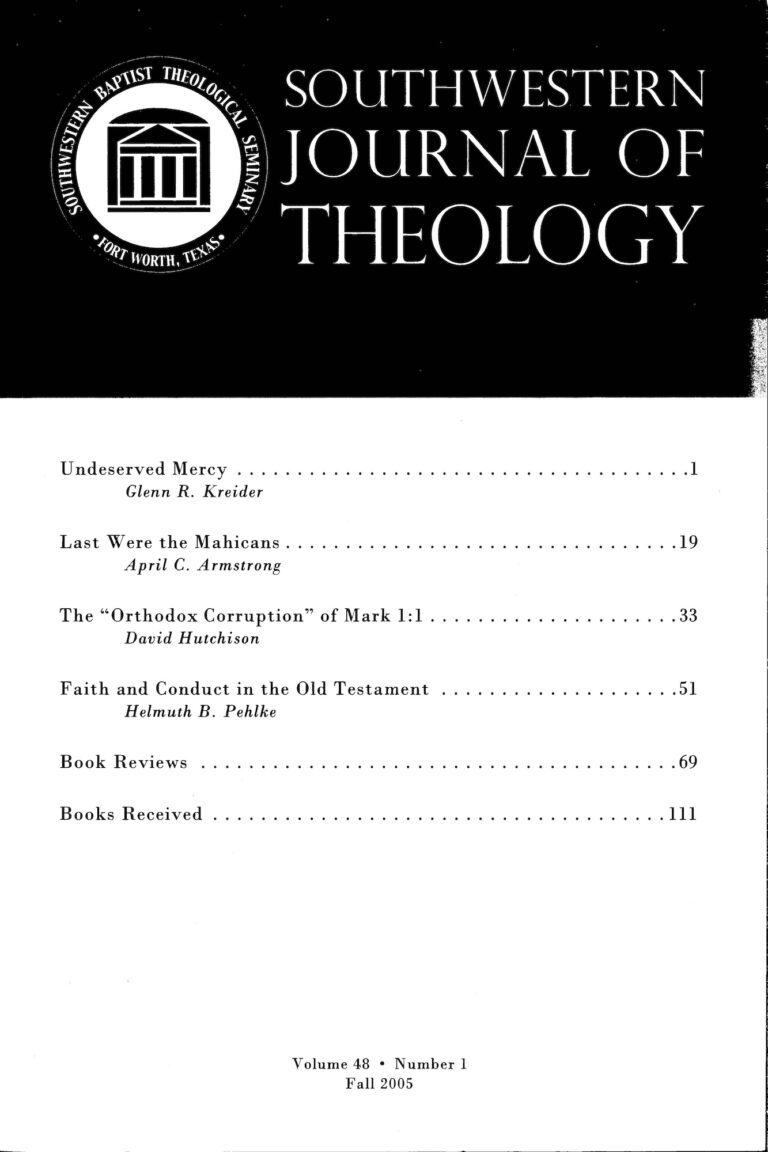
Southwestern Journal of Theology (48.1)
Southwestern Journal of Theology
Volume 48, No. 1 - Fall 2005
Editor: Paige Patterson
Edited by Harry S. Stout, Kenneth P. Minkema, and Caleb J. D. Maskell. Lanham, MD: University Press of America, 2005. 175 pages. Softcover, $29.95.
This book is a compilation of papers which were originally presented at the Library of Congress conference celebrating the tercentenary of the birth of Jonathan Edwards in October, 2003. Of the half a dozen conferences that sprung up around the county that year in observance of the tercentenary, this one was the most prestigious and scholarly, consisting of major names in the field of American Religious History (Mark Noll, George Marsden), senior specialists in the field of Edwards’s research (Sang Hyun Lee, Stephen J. Stein), and scholars who have made substantial contributions to the Edwards’s research in the last decade (Douglas A. Sweeney, Ava Chamberlain, Gerald R. McDermott, and Rachel Wheeler). The book represents a fine survey of the cutting-edge research going on in Edwards’s studies at the beginning of the twenty-first century.
The volume consists of thirteen essays categorized under various thematic headings such as the “Theology of History,” “Scripture,” “Society,” and “Race.” An interesting group of essays in the latter two headings reveal Edwards’s response to the various social and racial issues of the day, issues such as a sexual scandal in Northampton, the relationship between whites and Native Americans in Stockbridge, and the growing problem of slavery in the colonies. Ava Chamberlain’s article “Jonathan Edwards and the Politics of Sex in Eighteenth-Century Northampton” documents a scandalous case of fornication in Edwards’s congregation in the 1740s and his handling of the case by means of church discipline. The study paints a fascinating portrait of how Edwards in particular and New England society in general handled moral lapses in the church, and reveals Edwards’s conservative and authoritarian stance in handling the situation, a stance that contributed to his later dismissal from his Northampton church. Rachel Wheeler’s essay, “Lessons from Stockbridge: Jonathan Edwards and the Stockbridge Indians,” tests the limits of what we can really know about Edwards’s influence on the Stockbridge Indians and their influence on him based upon the historical sources. She makes an interesting case that his mission to the Stockbridge Indians in the final years of his life influenced the degree to which he emphasized the equality of human depravity (and hence the equality of all people) in his work on Original Sin. John Saillant in his essay “African American Engagements with Edwards in the Era of the Slave Trade” chronicles the fascinating popularity of Edwardsean Calvinism among American blacks and abolitionist writers in late eighteenth and early nineteenth-century America. Together, these essays reveal an Edwards thoroughly enmeshed in the life of eighteenth-century New England, rather than the more well-known Edwards of Calvinistic speculation and revivalist piety.
The section that has the most potential for fruitful scholarship I believe is found in the three essays under the category of “Scripture.” Douglas Sweeney’s study, “‘Longing for More and More of It’? The Strange Career of Jonathan Edwards’s Exegetical Exertions,” calls scholars to remember that Edwards was a man of the Bible first and foremost, and that if we want to understand his theology we need to understand his handling of scripture, his hermeneutics, and where Edwards is located in the history of biblical interpretation. Robert Brown’s work “The Sacred and the Profane Connected: Edwards, the Bible, and Intellectual Culture,” highlights Edwards’s response to the newer trajectories in eighteenth-century intellectual culture, including his lengthy defense of the Mosaic authorship of the Pentateuch, as well as his defense of the doctrine of the hell based (interestingly) on Newtonian physics and cosmology. Stephen Stein, who has studied Edwards’s interpretation of scripture for over thirty years, presents a darker portrait of Edwards, showing how he interpreted passages of scripture which involved violence. His essay, “Jonathan Edwards and the Cultures of Biblical Violence,” reveals an Edwards that is not necessarily complimentary to “morally sensitive individuals” (63). In his notebooks we find Edwards justifying Esther’s request to hang all of Haman’s ten sons (Esth. 9:13) because God had previously declared that he was against the Amalekites “from generation to generation” (Exod. 17:16). We also see Edwards justifying Herod’s decree to destroy the young children of Bethlehem (Matt. 2:16) because they refused “to entertain [Mary] in their houses when her travail came upon her” (Edwards’s quote). While we might not sanction such exegetical conclusions, an analysis of them in the context of Edwards’s theodicy might reveal an Edwards that is not so harsh.
The world of Edwards’s scholarship is ever expanding. One who wishes to read a work that summarizes the state of current research on Edwards need only to look at this excellent volume.





